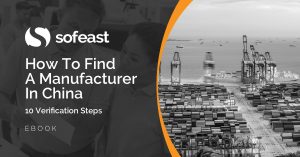 Factory audits in China and other Asian countries are often (loosely) based on a checklist inspired by the ISO 9000 series. That means the main part of these audits consists in looking for holes in the factory’s quality system.
Factory audits in China and other Asian countries are often (loosely) based on a checklist inspired by the ISO 9000 series. That means the main part of these audits consists in looking for holes in the factory’s quality system.
Why are ISO 9000 factory audits important? Because they directly impact the factory’s reliability (how likely are they to have quality problems and to miss deadlines).
Performing such an audit on a small workshop is over-kill. They probably have no system at all, and the auditor’s job is over in 20 min.
We have worked on a new template for our audit, and here are the checkpoints related to the quality system:
1. Understanding The Buyer’s Requirements
- Is there a clear list of all the desired characteristics of a product, before production starts?
- Is it clearly specified in which manner each requirement should be measured/tested?
- Are conform samples available to workers in production and QC areas? How accessible are these samples (photo on the production line, sample in hands of QC staff…)?
2. Suppliers of Materials / Components
- How does the factory evaluate and select material suppliers?
- Is there a list of approved suppliers?
- How does the factory communicate requirements to its material suppliers? Is it done properly and accurately?
3. Incoming Quality Control (IQC)
- What are the steps followed by the factory when it receives raw materials/components from its suppliers?
- How are materials/components checked against the factory’s specifications?
- Is any on-site test performed upon reception? Which one(s)?
- Do they send samples for tests in external laboratories? How often and for what tests?
- How are the materials/components stored?
- Describe the location (inside/outside/covered…) and the way the materials are stored (in bulk/on racks…).
- Are materials / components correctly identified? How (sticker/barcode/tag…)?
- Is the information easily accessible?
- Is there a First-In, First-Out (FIFO) system? Or any other stock management system?
- Are there QC staff solely dedicated to Incoming QC (IQC)? How many?
- Are QC results recorded in a formal report?
FREE Sofeast eBook: “How To Find A Manufacturer In China: 10 Verification Steps.”
Hit the button to get your copy:
4. Organization Of In-House Production
- Are clear procedures given to each operator, for each job/task (including the QC staff)?
- How does the factory verify that each production process is conducted in a satisfactory manner?
- How are work-in-process products stored? Are they protected and kept clean?
- Are production lots properly identified and traceable throughout the production processes?
- Does the factory accept to do pilot runs (very small quantities) for the products it makes for the first time?
5. In-Process Quality Control (IPQC)
- What are the control steps during production?
- What proportion of products is checked?
- What does the factory do with the data collected (corrective/preventive actions plans)?
- What happens to defective products? (repaired / recycled / scrapped…)
- Are there QC staff solely dedicated to In-Process QC (IPQC)? How many?
- Are QC results recorded in a formal report?
6. Subcontracted production
- Are materials/components delivered directly to subcontractors? Are they checked?
- How does the factory control the work of its subcontractor(s)?
- When do they check the subcontractors’ operations?
- Are QC findings recorded in a formal report?
7. Final Quality Control (FQC)
- How are finished products stored?
- Does Final QC occur before or after packing is completed?
- What proportion of products is checked?
- How are inspected samples taken from the production line? (by lot, randomly…)
- If the final inspection based on random checking: It is based on which inspection level, and on which AQL level?
- What happens when non-conformities are detected?
- Are there QC staff solely dedicated to Final QC (FQC)? How many?
- Are QC results recorded in a formal report?
8. Instruments & Machines
- How does the factory ensure that measuring instruments are available and correctly used?
- Are testing instruments regularly calibrated?
- How often are production machines maintained?
- Are maintenance records available?
9. Prevention Of Problems
- What is the process in case an issue is noticed during the preparation of samples?
- What is the process in case an issue is noticed during bulk production?
- Does the factory determine the root causes of non-conformities?
- What actions are put in place so that they don’t occur again?
- Do they determine potential non-conformities and take preventive actions?
Important note: this is not the checklist followed when a manufacturer wants to be “ISO 9001 certified” (which does not mean much in countries like China). This is the checklist our auditors follow when they help an importer evaluate the reliability of a potential supplier.
What do you think?
Are you trying to find a manufacturer in China who is well-suited to your needs and can also deliver on their promises?
Sofeast has developed 10 verification steps to help importers find the right manufacturing partner in China. They’re shared in this FREE eBook: “How To Find A Manufacturer In China: 10 Verification Steps.”
It covers:
- Background checks
- Manufacturing capabilities
- Quality system auditing
- Engineering resources
- Pricing, negotiation, & contracts
- …and much, much more
Just hit the button below to get your copy and put yourself in a great position to get better results from Chinese manufacturers who supply your products:


The check list is almost good in my view but can be better and inclusive more in detailed items. this is regarding to my exp. and you may skip it 😉
good stuff btw.
Mansour,
Of course it is not the full ISO 9001 checklist… Just the most relevant checkpoints (in my humble opinion) for assessing a subcontractor’s reliability in a country like China.
I find it useful..thanks
Welcome, Hazel!